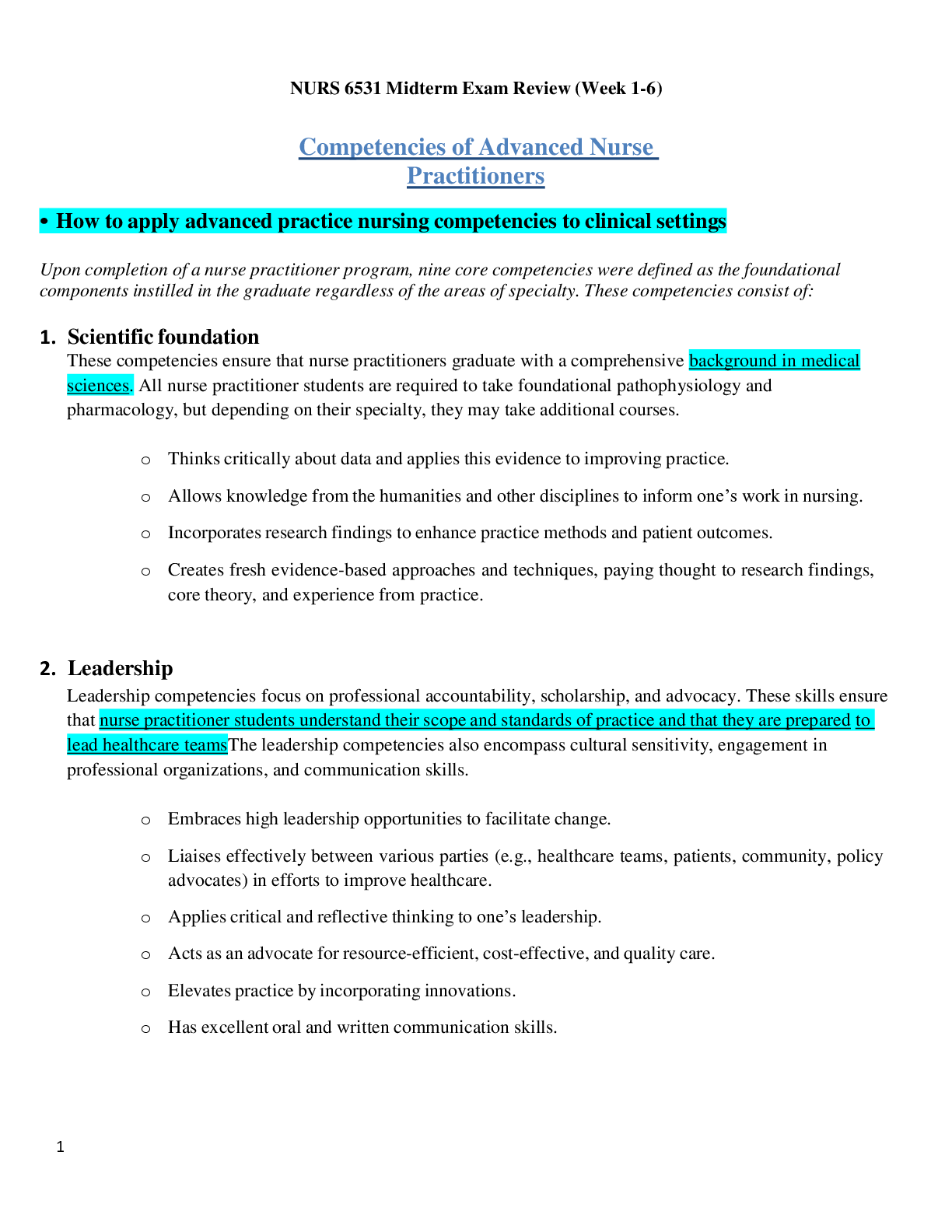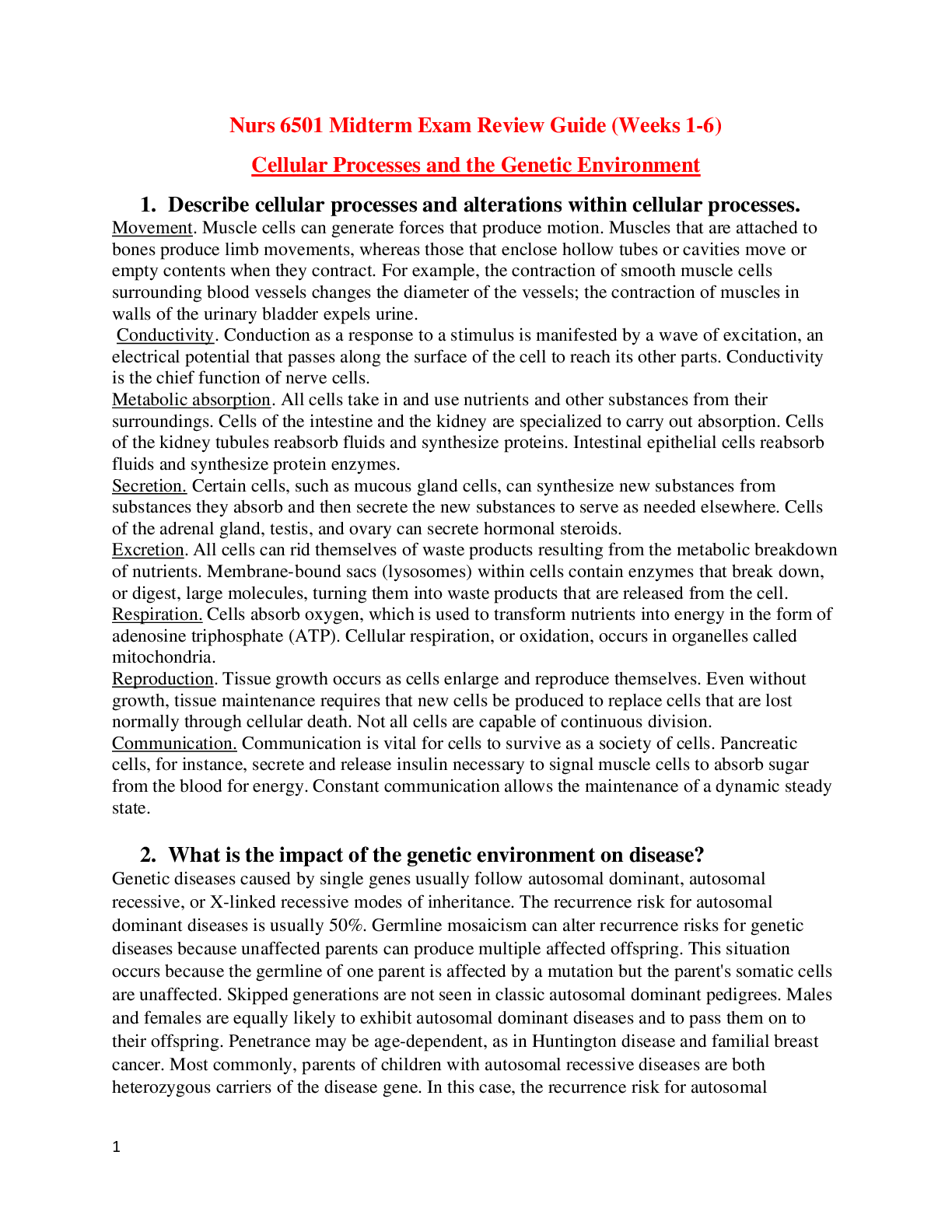*NURSING > EXAM REVIEW > Walden University NURS 6501 Midterm Comprehensive Exam Review. (Week 1-6) All Topics Covered. A+ (All)
Walden University NURS 6501 Midterm Comprehensive Exam Review. (Week 1-6) All Topics Covered. A+
Document Content and Description Below
NURSING 6501 Midterm Exam Review Guide (Weeks 1-6) Cellular Processes and the Genetic Environment 1. Describe cellular processes and alterations within cellular processes. Movement. Muscle cells ca... n generate forces that produce motion. Muscles that are attached to bones produce limb movements, whereas those that enclose hollow tubes or cavities move or empty contents when they contract. For example, the contraction of smooth muscle cells surrounding blood vessels changes the diameter of the vessels; the contraction of muscles in walls of the urinary bladder expels urine. Conductivity. Conduction as a response to a stimulus is manifested by a wave of excitation, an electrical potential that passes along the surface of the cell to reach its other parts. Conductivity is the chief function of nerve cells. Metabolic absorption. All cells take in and use nutrients and other substances from their surroundings. Cells of the intestine and the kidney are specialized to carry out absorption. Cells of the kidney tubules reabsorb fluids and synthesize proteins. Intestinal epithelial cells reabsorb fluids and synthesize protein enzymes. Secretion. Certain cells, such as mucous gland cells, can synthesize new substances from substances they absorb and then secrete the new substances to serve as needed elsewhere. Cells of the adrenal gland, testis, and ovary can secrete hormonal steroids. Excretion. All cells can rid themselves of waste products resulting from the metabolic breakdown of nutrients. Membrane-bound sacs (lysosomes) within cells contain enzymes that break down, or digest, large molecules, turning them into waste products that are released from the cell. Respiration. Cells absorb oxygen, which is used to transform nutrients into energy in the form of adenosine triphosphate (ATP). Cellular respiration, or oxidation, occurs in organelles called mitochondria. Reproduction. Tissue growth occurs as cells enlarge and reproduce themselves. Even without growth, tissue maintenance requires that new cells be produced to replace cells that are lost normally through cellular death. Not all cells are capable of continuous division. Communication. Communication is vital for cells to survive as a society of cells. Pancreatic cells, for instance, secrete and release insulin necessary to signal muscle cells to absorb sugar from the blood for energy. Constant communication allows the maintenance of a dynamic steady state. 2. What is the impact of the genetic environment on disease? Genetic diseases caused by single genes usually follow autosomal dominant, autosomal recessive, or X-linked recessive modes of inheritance. The recurrence risk for autosomal dominant diseases is usually 50%. Germline mosaicism can alter recurrence risks for genetic diseases because unaffected parents can produce multiple affected offspring. This situation occurs because the germline of one parent is affected by a mutation but the parent's somatic cells are unaffected. Skipped generations are not seen in classic autosomal dominant pedigrees. Males and females are equally likely to exhibit autosomal dominant diseases and to pass them on to their offspring. Penetrance may be age-dependent, as in Huntington disease and familial breast cancer. Most commonly, parents of children with autosomal recessive diseases are both heterozygous carriers of the disease gene. In this case, the recurrence risk for autosomal recessive diseases is 25%. Males and females are equally likely to be affected by autosomal recessive diseases. The frequency of genetic diseases approximately doubles in the offspring of first-cousin matings. In each normal female somatic cell, one of the two X chromosomes is inactivated early in embryogenesis. X inactivation is random, fixed, and incomplete (i.e., only part of the chromosome is actually inactivated). It may involve methylation. Gender is determined embryonically by the presence of the SRY gene on the Y chromosome. Embryos that have a Y chromosome (and thus the SRY gene) become males, whereas those lacking the Y chromosome become females. When the Y chromosome lacks the SRY gene, an XY female can be produced. Similarly, an X chromosome that contains the SRY gene can produce an XX male. X-linked genes are those that are located on the X chromosome. Nearly all known X-linked diseases are caused by X-linked recessive genes. Males are hemizygous for genes on the X chromosome. X-linked recessive diseases are seen much more often in males than in females because males need only one copy of the gene to express the disease. Fathers cannot pass X- linked genes to their sons. Skipped generations are often seen in X-linked recessive disease pedigrees because the gene can be transmitted through carrier females. Recurrence risks for X- linked recessive diseases depend on the carrier and affected status of the mother and father. A sex-limited trait is one that occurs in only one of the sexes. A sex-influenced trait is one that occurs more often in one sex than in the other. Congenital diseases are those present at birth. Most of these diseases are multifactorial in etiology. Multifactorial diseases in adults include coronary heart disease, hypertension, breast cancer, colon cancer, diabetes mellitus, obesity, AD, alcoholism, schizophrenia, and bipolar affective disorder. It is incorrect to assume that the presence of a genetic component means that the course of a disease cannot be altered—most diseases have both genetic and environmental aspects. 3. Explain how healthy cell activity contributes to good health and how its breakdown in cellular behavior and alterations to cells lead to health issues. Cells adapt to their environment to escape and protect themselves from injury. An adapted cell is neither normal nor injured—its condition lies somewhere between these two states. Adaptations are reversible changes in cell size, number, phenotype, metabolic activity, or functions of cells. 1 However, cellular adaptations are a common and central part of many disease states. In the early stages of a successful adaptive response, cells may have enhanced function; thus, it is hard to differentiate a pathologic response from an extreme adaptation to an excessive functional demand. The most significant adaptive changes in cells include atrophy (decrease in cell size), hypertrophy (increase in cell size), hyperplasia (increase in cell number), and metaplasia (reversible replacement of one mature cell type by another less mature cell type or a change in the phenotype). Dysplasia (deranged cellular growth) is not considered a true cellular adaptation but rather an atypical hyperplasia. Injury to cells and to extracellular matrix (ECM) leads to injury of tissues and organs ultimately determining the structural patterns of disease. Loss of function derives from cell and ECM injury and cell death. Cellular injury occurs if the cell is “stressed” or unable to maintain homeostasis in the face of injurious stimuli or cell stress. Injured cells may recover (reversible injury) or die (irreversible injury). Injurious stimuli include chemical agents, lack of sufficient oxygen (hypoxia), free radicals, infectious agents, physical and mechanical factors, immunologic reactions, genetic factors, and nutritional imbalances. Cell injury and cell death often result from exposure to toxic chemicals, infections, physical trauma, and hypoxia. 4. What are the roles genetics plays in disease processes? See answer for question 2. 5. What is the relationship of how cells are involved in disease processes? Common biochemical mechanisms are important to understanding cell injury and cell death regardless of the injuring agent. These mechanisms include adenosine triphosphate (ATP) depletion, mitochondrial damage, accumulation of oxygen and oxygen-derived free radicals, membrane damage (depletion of ATP), protein folding defects, DNA damage defects, and calcium level alterations. Examples of cell injury are (1) ischemic and hypoxic injury, (2) ischemia-reperfusion injury, (3) oxidative stress or accumulation of oxygen-derived free radicals–induced injury, and (4) chemical injury. Altered cellular and tissue biology can result from adaptation, injury, neoplasia, accumulations, aging, or death. Knowledge of the structural and functional reactions of cells and tissues to injurious agents, including genetic defects, is key to understanding disease processes. Cellular injury can be caused by any factor that disrupts cellular structures or deprives the cell of oxygen and nutrients required for survival. Injury may be reversible (sublethal) or irreversible (lethal) and is classified broadly as chemical, hypoxic (lack of sufficient oxygen), free radical, unintentional or intentional, and immunologic or inflammatory. Cellular injuries from various causes have different clinical and pathophysiologic manifestations. Stresses from metabolic derangements may be associated with intracellular accumulations and include carbohydrates, proteins, and lipids. Sites of cellular death can cause accumulations of calcium resulting in pathologic calcification. Cellular death is confirmed by structural changes seen when cells are stained and examined with a microscope. The most important changes are nuclear; clearly, without a healthy nucleus, the cell cannot survive. The two main types of cell death are necrosis and apoptosis, and nutrient deprivation can initiate autophagy that results in cell death. Altered Physiology 6. Evaluate cellular processes and alterations within cellular processes. Injury to cells and their surrounding environment, called the extracellular matrix, leads to tissue and organ injury. Although the normal cell is restricted by a narrow range of structure and function, it can adapt to physiologic demands or stress to maintain a steady state called homeostasis. Adaptation is a reversible, structural, or functional response to both normal or physiologic conditions and adverse or pathologic conditions. For example, the uterus adapts to pregnancy— a normal physiologic state—by enlarging. [Show More]
Last updated: 2 years ago
Preview 1 out of 137 pages

Buy this document to get the full access instantly
Instant Download Access after purchase
Buy NowInstant download
We Accept:

Reviews( 0 )
$12.00
Can't find what you want? Try our AI powered Search
Document information
Connected school, study & course
About the document
Uploaded On
Apr 14, 2021
Number of pages
137
Written in
Additional information
This document has been written for:
Uploaded
Apr 14, 2021
Downloads
0
Views
110










COS1512.png)

ACC 422 TESTB.png)



